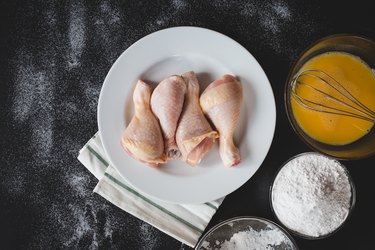
Slimy chicken, raw chicken that smells like eggs, grey-colored chicken: These are all signs that your chicken has gone bad. Avoid chicken spoilage by taking the proper safety precautions.
Raw Chicken Gone Bad
Video of the Day
There are plenty of ways to spot spoiled raw chicken. According to Ask USDA, one way of determining whether chicken has gone bad is its color; spoilage can cause chicken to turn a dark shade. But keep in mind that a change in color doesn't always denote spoilage.
Video of the Day
The USDA Food Safety and Inspection Service (USDA FSIS) explains that color changes can be normal for fresh product and that you should look for other signs of spoilage, such as smell and texture. Raw chicken that's spoiled will be sticky or slimy to the touch. This indicates high bacterial numbers, says Ask USDA. It's also likely to have an unpleasant, rancid odor.
According to Kids Health From Nemours, you should always check the sell-by date. If the chicken is long past its sell-by date, then throw it out. Even if it's one day past the expiration date, it's best to err on the side of safety and toss it.
Dangers of Consuming Spoiled Chicken
Suppose you do end up accidentally consuming spoiled chicken. Maybe you left the chicken in the refrigerator or freezer for too long or you left it out at room temperature or in the heat for an extended period of time What's going to happen then? FoodSafety.gov. explains that you can contract a foodborne illness.
Symptoms of food poisoning include an upset stomach and stomach cramps, nausea, fever, vomiting, signs of dehydration and more serious long-term effects that may include kidney failure and chronic arthritis. If your symptoms are serious — for instance, if you have a fever over 102 degrees Fahrenheit or if you have bloody stool, then it's best to consult your doctor as soon as possible.
FoodSafety.gov also explains that certain people are more susceptible to foodborne illnesses. Pregnant women, adults over 65, children under 5 and people with weakened immune systems, for example, are more likely to get sick from spoiled food.
Read more: How to Bake a Plain Chicken Breast
Proper Chicken Storage and Handling
Fortunately, there are ways to prevent chicken from spoiling. Practicing safe handling and storage is a start. The USDA FSIS recommends proper storage time for both cooked and raw chicken.
For the most part, raw chicken can be stored in the refrigerator for up to two days, while cooked chicken can be refrigerated for up to four days. Raw chicken can generally be stored in the freezer for up to nine months, whereas cooked chicken normally stays good for about four months.
For safe storage, the USDA FSIS also suggests following the handling recommendations on the package, keeping the chicken in its package until it's ready to be used and freezing the chicken in its original packaging or overwrapping it with airtight heavy-duty foil, plastic wrap or freezer paper.
If you're planning to defrost chicken, the USDA FSIS explains how to do it safely to help prevent spoilage. Do not, under any circumstances, allow the meat to thaw at room temperature. Instead, defrost it in the refrigerator, microwave it or put it in a bath of cold water. Leaving meat out at room temperature for more than a couple of hours can cause spoilage.